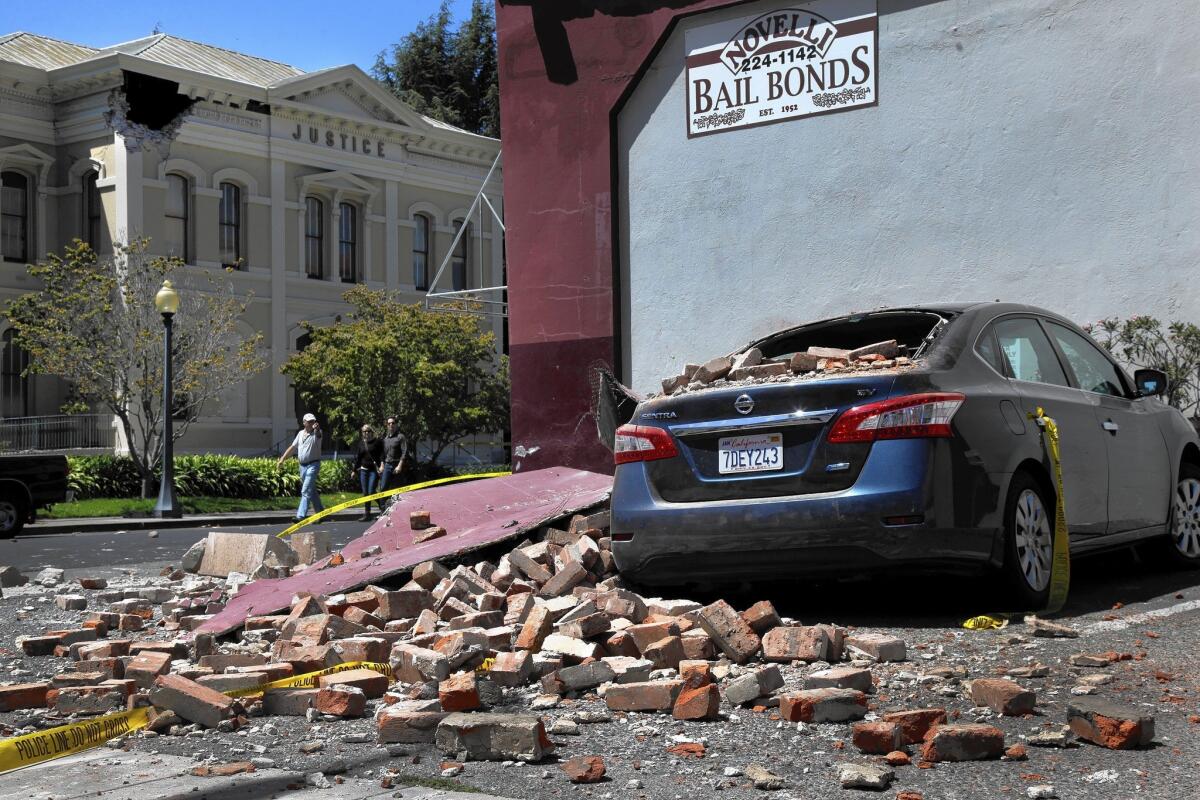Quake alerts’ success spurs effort to complete early-warning system

Reporting from BERKELEY — When the 6.0 earthquake struck Napa County last month, a computer at a university lab here raced to warn agencies across the Bay Area.
BART received an alert ordering trains to stop. San Francisco 911 operators had eight seconds to brace for an onslaught of calls. UC police managed to send out a “code red” on their radio system before the shaking started.
The earthquake was the largest to occur in a highly populated area of California since scientists and government officials began testing a seismic early warning system. By most accounts, the system was a success this time. A countdown alert reached various parts of the Bay Area — about 30 miles south of the epicenter — in time to take action.
State legislators and local officials are now hoping to use this test run to speed up completion of the system, which has been slowed by a lack of financing. Scientists hope to eventually send out warnings to the public on cellphones and computers.
At the International Conference on Earthquake Early Warning on Wednesday at UC Berkeley, several California elected officials outlined funding ideas, including tapping bond money and seeking emergency appropriations from the Legislature.
San Francisco Mayor Ed Lee said in an interview Wednesday that the city was impressed by how much officials could do with the eight seconds of warning, and they are already working on how to take better advantage of the system.
San Francisco has hired a private company, Regroup, to identify other city departments and private industries that might want an automatic feed from the system, including building owners who would want elevators to automatically stop at the next floor before the shaking arrived.
Lee said the warning system also could be used at hospitals, so surgeons could remove scalpels before tremors start.
“All of them have a great stake in early warning,” he said.
The system offered an early alert on several quakes this year. Scientists in Pasadena got six seconds of warning when the 5.1 La Habra quake struck in March.
Earthquakes travel at the speed of sound, and sensors that initially detect the shaking near the epicenter can send a message faster — at the speed of light — to warn residents farther away that the quake is coming.
Once fully developed, the system could give metropolitan L.A. a minute of warning that “the Big One” was headed from the San Andreas fault, officials said.
The amount of warning time would depend on how far the recipient was from the epicenter. When the Napa quake struck, Berkeley got a five-second warning and San Francisco an eight-second warning, said Richard Allen, director of the UC Berkeley Seismological Laboratory. San Jose would have received a 12-second warning had someone been testing the system there.
The computer sent an alert to BART, which would have automatically halted service to avoid derailments. But because the quake occurred on a Sunday at 3:20 a.m., no cars were running at the time.
Downtown Napa, which saw significant damage, did not get an early warning because the epicenter was so close to the city. But Allen said technology is advancing enough that even communities near epicenters could eventually get at least some type of alert.
The cost of building and operating an early earthquake warning system for the West Coast — including California, Oregon and Washington — is estimated to be about $120 million over five years. California’s share is about $80 million.
In endorsing the system last year, the state Legislature mandated that it be a public-private partnership.
The legislation says that no state general fund money can be used to cover the $80-million price tag. The state is now looking for funding to cover those costs before January 2016.
On Wednesday, state Sen. Alex Padilla (D-Pacoima) said he wants to reconsider this approach and is open to using state general fund money to complete it.
Another idea would be to request money from a $7.5-billion water bond measure on the November ballot, with backers arguing an early warning could help protect the state’s water infrastructure.
Padilla and Lt. Gov. Gavin Newsom also suggested an emergency appropriation from the Legislature coupled with grants from utilities, hospitals and private industries that would benefit from the system.
“I am not expecting the whole system to be funded from any single source,” Padilla said, adding that it’s most crucial to secure $25 million to get a basic system up and running.
This summer, a U.S. congressional committee recommended spending $5 million on the California system, but it remains unclear whether the full Congress will embrace the idea.
Newsom noted that other countries, including Japan, Mexico, Romania and Turkey, already use similar systems.
“It’s long overdue,” he said. “We are finding money for a high-speed rail system — all from creative sources — but we haven’t been as creative to fund an early warning system?”
[email protected]
Twitter: @ronlin
More to Read
Sign up for Essential California
The most important California stories and recommendations in your inbox every morning.
You may occasionally receive promotional content from the Los Angeles Times.











